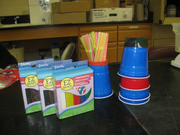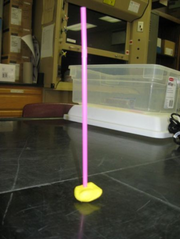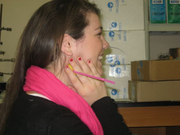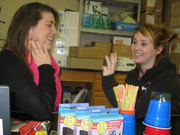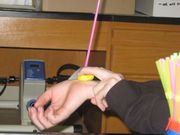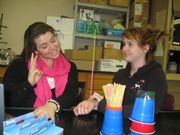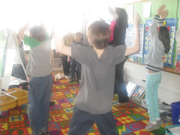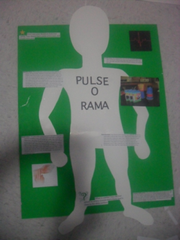Pulse-o-rama!
| Instant wiki maker | Making handouts | Editing tips |
Biology In Elementary Schools is a Saint Michael's College student project from a course that ran between 2007 and 2010 and fully described in this book chapter. The student-created resources have been preserved here for posterity. Link under 'toolbox' for printer-friendly versions of the exercises. Click on handouts to print full resolution versions. Please see Wikieducator's disclaimer, our safety statement, and the Creative Commons licensing in English and in legalese.
Student worthiness
Currently the different parts of our experiments have been tested a few times and worked every time!
Primary biological content area covered
This experiment will expose students to both the Respiratory System and Circulatory System.
Materials
- Stopwatch
- Plastic or Paper cup with bottom cut open
- Or an empty toilet paper roll
- If you want to make the plastic cups smoother consider covering the cups with cloth or fabric
- Or an empty toilet paper roll
- Straws (two for each student)
- Clay
Handouts
http://www.wikieducator.org/Image:Pulse-o-rama.jpg
http://www.wikieducator.org/Image:Pulse-o-ramapt2smc.jpg
Description of activity
In this activity, the students will learn about their respiratory system and how heart rate increases with exercise. This will involve a number of active movements, such as sitting still, walking around the room, and then either running or jumping jacks. In between each activity, the students will use a home-made pulse-counter in order to count how many times their heart rate beats in a 30 second period. The students will be partnered together so that they can count the number of times the home-made device moves, making it easier for the students to complete the activity. The students will also be asked to fill out a handout in order to help record and analyze their data.
Lesson plan
1. Demonstrate the two most common places to find a pulse, neck and wrist.
2. Ask each student to find theirs, assist any student who is having trouble.
3. Demonstrate how the students can place straws firmly into the clay, press the clay against their neck or their wrists and watch the straw move up and down.
4. Pass out a straw and a piece of clay to each student.
5. Put the students into partners.
6. Have students construct the pulse reader with clay and two straws.
7. Have one person from each pair place their pulse reader on their neck.
8. Have the other partner count each time that they see the straw move.
9. Start the stopwatch and tell students to begin counting, after 30 seconds stop the stopwatch and tell them to stop counting and then record that number.
10. Repeat with other partner.
11. Have half the group walk a few laps around the room or in the hall and then come back and place the pulse reader back on the neck and repeat the counting process.
12. Repeat with second half of the group.
13. Then have half the students run up and down the hallway or do a few minutes of jumping jacks and then place the pulse reader on the neck and repeat the counting process.
- It is important to check at the beginning of the lesson that each student is feeling in good health and is able to do exercise, if not they only need to do the first two actions.
14. Repeat with second half of group.
15. Have students record their data on the given handout after each session of checking their heart rates.
16. Afterwards, have the students graph their results on a line graph and answer the last question of the handout about what happens to heart rate as exercise increases.
17. Bring the class together in order to brainstorm ideas about why this happens.
Potential pitfalls
It may be difficult at first for the children to locate their pulse if they have never before.
Math connections
The students must count up the number of pulse beats per minute in order to determine their heart rate. After exercising for five minutes, the students must count up the number of pulse beats per minute again. Then they will compare the two numbers and determine which one caused their heart rate to increase and figure out how large the difference between the two is.
Literature connections
The students must record their answers on the handout and communicate why their heart rate increases with heart rate. It would also be beneficial to read to the students at the end of the activity, for example we have the book "Froggy goes to the doctor" by Jonathan London.
Connections to educational standards
This experiment connects to the following Vermont Standards of Education:
7.9-a: Students use statistics and probability concepts. This is evident when students: Collect, order, display, and analyze data in order to answer questions or test a hypothesis.
7.14-b: Students demonstrate understanding of the human body — heredity, body systems, and individual development — and understand the impact of the environment on the human body. This is evident when students: Identify the parts of the human body, and demonstrate understanding of how the parts work together to perform functions that satisfy common needs.
Next steps
The students can use the information they learned about the respiratory system and apply it to other systems of the body. Once they know how one system works, it will be easier for them to understand the human body as a whole. Students will also learn how beneficial exercise and raising your pulse can be!
Reflections
This lesson went really well! As we worked out certain kinks it got easier each time we tried it. Originally we were somewhat crunched on time so we decided to shorten some activities and focus more on the counting and recording of the pulses. The students all came to the activity with a good idea as to what a pulse was but they left the activity with an even greater understanding. The students responded really well to being able to get up and run around and do jumping jacks, they also responded well to being able to construct the pulse measurer from clay and straws. The students were a little hesitant to do the math but they seemed more than willing once it was tied to such a fun activity!
Citations and links
London, Jonathan, and Frank Remkiewicz. Froggy Goes to the Doctor. New York: Puffin, 2004. Print.

